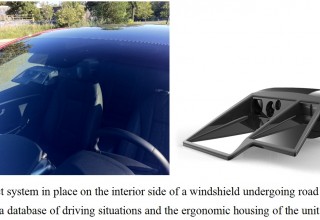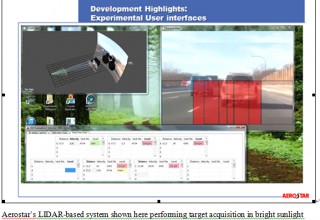Aerostar Industry Co. Announces Ground-breaking TRL6 LIDAR And Camera Fusion ADAS (Advanced Driver Assistance System)
Aerostar Industry Co. announced today successful TRL6 testing of its ground-breaking LIDAR and camera fusion ADAS. Aerostar plans to quickly move the system into TRL9 testing and have full integration into end user's cars by 2014.
Online, September 9, 2013 (Newswire.com) - Aerostar Industry Co. announced today successful TRL6 testing of its ground-breaking LIDAR and camera fusion ADAS (Advanced Driver Assistance System). The ADAS performed analog acquisition of pedestrians, automobiles and other uncooperative targets all during varying weather conditions ranging from direct sunlight to light rain and fog. This testing phase is the result of a legacy of 20 years of developmental work and years of extensive in-house ADAS development work which led to proof of concept demonstrations and a test drive of an early Model 100 LIDAR and camera fusion system in 2011.
Now that low cost design has been transformed into a TRL6 level testing design that with some modifications can be easily integrated into any existing automotive platform. Aerostar's design has already undergone extensive software and algorithm work, preparing the platform for Tier 1 customer integration and allowing end users to seamlessly switch between different vehicles - from economy cars to SUVs to luxury automobiles. Although designed with immediate requirements like obstacle detection and avoidance in mind, the system contains the processing power for future, more complicated requirements and expansion, including, but not limited to, 3D navigation and a 360 degree FOV. Utilizing strictly automotive grade components, the ADAS has a high-grade LIDAR that works across all environmental conditions and is not significantly impacted by weather, type of obstacle or terrain.
According to Jean-Yves Deschênes, CTO, Aerostar "We combine the best of all technologies - a superior LIDAR/camera fusion system, housed in a compact, interior windshield- mountable unit with the ease of quick and inexpensive end user integration."
During testing, Aerostar's ADAS reached benchmarks that most known LIDAR-based systems are unable to achieve. In one notable example, the system was able to discern an extremely close-range large object (a car) while still identifying pedestrians passing right next to the obstacle. Jay Young Wee, Vice President, Aerostar, stated "In the past, this has been a major weakness of LIDAR systems. LIDAR, utilizing pulses of light, can typically be "blinded" by a very close, large object due to saturation. It is analogous to a person having a very bright light shone into their eyes from a few inches away. But our system, with its proprietary algorithm, was able to accurately identify both objects."
Aerostar plans to quickly move the system into TRL9 testing and have full integration into end user's cars by 2014. Unlike many past LIDAR-based ADAS, the platform is designed to test for multiple sensor boards at the manufacturing level thus making it possible for automotive customers to perform simple go - no go testing at the assembly line and to enable a cost-effective, efficient transition into mass production.
For more information, contact Stephen at (516) 677-5390 or visit Aerostar at aerostarusa.com.


